Research - (2021) Volume 9, Issue 1
Awareness on Confidence Level among College Students
Shilpa Merlyn Jose, Vishnu Priya V* and Gayathri R
*Correspondence: Vishnu Priya V, Department of Biochemistry, Saveetha Dental College and Hospitals, Saveetha Institute of Medical and Technical Sciences, Saveetha University Tamilnadu, India, Email:
Abstract
Self-confidence is the understanding to trust our own judgment and abilities which make us value ourselves. Self-confidence plays a vital role in our lives. Self-confident people are more successful in the future than people with less confidence. Self-confidence can be improved by setting achieving goals. The aim of this study is to create awareness on confidence levels among college students. The study consists of questions administered to 115 participants through an online survey planet link. The study participants were college students of age group 18 – 25 years. Self-confidence influences the mood and behaviors of students. Many people have positive vibes but they lack self-confidence. Among the 100 students, 80% of the students were overconfident and 92.2% of them said that self-confidence increased their self-esteem. People who lack self-confidence gain confidence level by their role models or by the people who have already achieved their dreams. They also gain confidence levels with the help of teachers and parents due to their continuous care and motivation. We can achieve self-confidence by affirming ourselves. Seminars, workshops on motivation, time management may be conducted in schools and colleges to boost the confidence level of students. Increase in confidence level will make the students to achieve higher positions in the society.
Keywords
Self-confidence, Confidence level, Survey planet, Online questionnaire
Introduction
Self-confidence is a feeling of trust in their abilities. Parents, faculties and friends interaction can create a great impact on a student's confidence level [1]. Psychometric properties and behavioral relationships with other individuals describe one’s confidence level [2]. Students with diverse experiences and more positive interactions with peers have more selfconfidence in academics [3]. Positive Friendships can bring the best out of an individual; because of this they can develop more self-confidence [4].
Students studying in medical colleges who have witnessed cardiac arrest are assumed to have less confidence level [5]. Students who are starting their work as clinical nurses also have less confidence because they are not used to that surrounding [6]. Parental education has also proved to affect student’s self-confidence [7]. More clinical practice involved teaching developed more confidence among final year nursing students [8]. International students because of their difference in their language and culture lack confidence level [9]. Medical students were compared between experience, competence and confidence but these domains had no connections between them [10]. Positive verbal persuasion was used as a tool to enhance self-confidence among students [11]. Students in the surgical field always tend to have more confidence levels [12]. If student - faculty interaction is good then university students tend to have a good academic confidence [13]. Students may lack confidence because of the experience in college but they can overcome these difficulties with their friends and faculty members [14].
There is no proper research done among college students and their level of self-confidence. Previous studies on cancer biology, nano materials, herbal products [15-20] motivated me to pursue this current research which is useful to our community. The main aim of this study is to create awareness on confidence levels among college students.
Materials and Methods
Self-structured questionnaire based on awareness on confidence level was administered to the study population through an online survey planet link. The study population included college students belonging to 18 to 25 years of age group. The participants were explained about the purpose of study in detail. The questions were carefully studied and the participants marked the corresponding answers. The data was collected and statistically analysed.
Results and Discussion
Questionnaire based survey on confidence level in which study population included college students was completed. The data was collected and statistically analyzed. 49.6% of participants felt that they boost their self-confidence by rewarding their achievements and 50.4% of them boost their self-confidence from the start (Figure 1). 42.6% of participants said that comparing them with others degraded their self-confidence and 57.4% of them said that comparing them with others did not degrade their self-confidence (Figure 2). 92.2% of them said that selfconfidence increased their self-esteem and 7.8% of them said that self-confidence did not increase self-esteem (Figure 3). 80% of students said that lack of confidence affected their future goals and 20% of them said that lack of confidence did not affect their future goals (Figure 4).
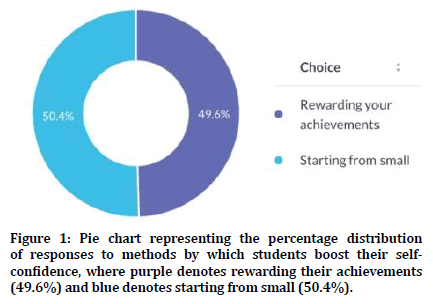
Figure 1. Pie chart representing the percentage distribution of responses to methods by which students boost their selfconfidence, where purple denotes rewarding their achievements (49.6%) and blue denotes starting from small (50.4%).
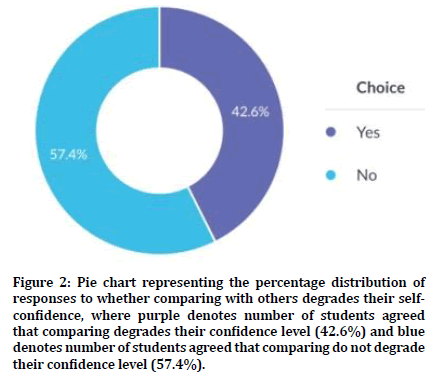
Figure 2. Pie chart representing the percentage distribution of responses to whether comparing with others degrades their selfconfidence, where purple denotes number of students agreed that comparing degrades their confidence level (42.6%) and blue denotes number of students agreed that comparing do not degrade their confidence level (57.4%).
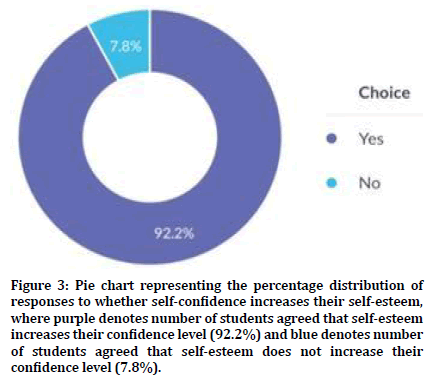
Figure 3. Pie chart representing the percentage distribution of responses to whether self-confidence increases their self-esteem, where purple denotes number of students agreed that self-esteem increases their confidence level (92.2%) and blue denotes number of students agreed that self-esteem does not increase their confidence level (7.8%).
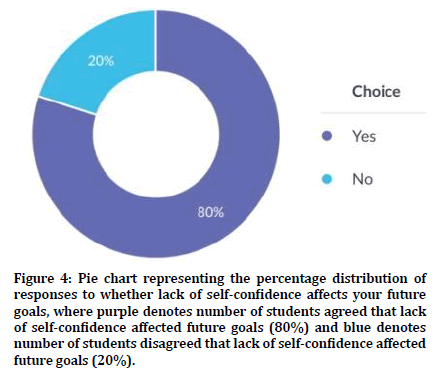
Figure 4. Pie chart representing the percentage distribution of responses to whether lack of self-confidence affects your future goals, where purple denotes number of students agreed that lack of self-confidence affected future goals (80%) and blue denotes number of students disagreed that lack of self-confidence affected future goals (20%).
70.4% of the participants said that lack of selfconfidence increases frustration towards life and 29.6% of them said that that lack of selfconfidence decreased frustration towards life (Figure 5). 69.6% of the participants said that they were satisfied with their inbuilt confidence and 30.4% of them said that they are not satisfied with their inbuilt confidence (Figure 6). 87% of them had a positive attitude within themselves and 13% of them did not have a positive attitude within themselves (Figure 7). 82.6% of them felt proud of themselves and 17.4% of them were not proud of themselves (Figure 8). 93% of them feel that they had good qualities and 7% of them feel that they do not have good qualities (Figure 9).
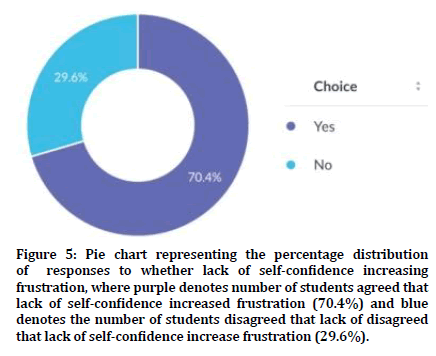
Figure 5. Pie chart representing the percentage distribution of responses to whether lack of self-confidence increasing frustration, where purple denotes number of students agreed that lack of self-confidence increased frustration (70.4%) and blue denotes the number of students disagreed that lack of disagreed that lack of self-confidence increase frustration (29.6%).
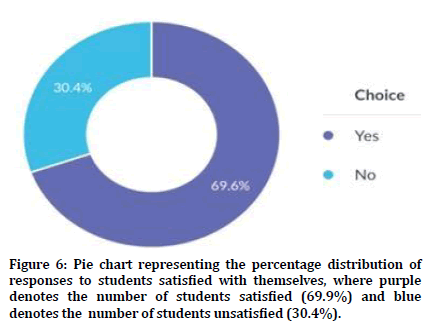
Figure 6. Pie chart representing the percentage distribution of responses to students satisfied with themselves, where purple denotes the number of students satisfied (69.9%) and blue denotes the number of students unsatisfied (30.4%).
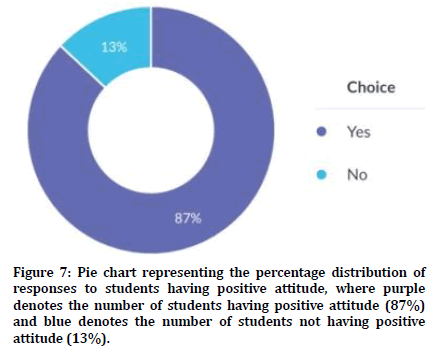
Figure 7. Pie chart representing the percentage distribution of responses to students having positive attitude, where purple denotes the number of students having positive attitude (87%) and blue denotes the number of students not having positive attitude (13%).

Figure 8. Pie chart representing the percentage distribution of responses to students proud of themselves, where purple denotes the number of students proud of themselves (82.6%) and blue denotes number of students not proud of themselves (17.4%).
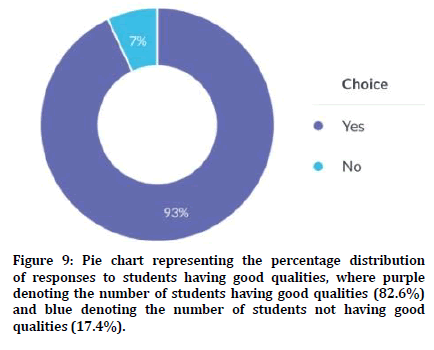
Figure 9. Pie chart representing the percentage distribution of responses to students having good qualities, where purple denoting the number of students having good qualities (82.6%) and blue denoting the number of students not having good qualities (17.4%).
89.6% of participants felt that they were able to do the things that others do and 10.4% of them feel that they were not able to do the things that others do (Figure 10). 80% of them were overconfident and 20% of them were not over confident (Figure 11). 60% of them agreed that they were creative and 40% of them disagreed (Figure 12). 64.3% of them said that they had participated in every activity even though they were embarrassed or nervous (Figure 13).
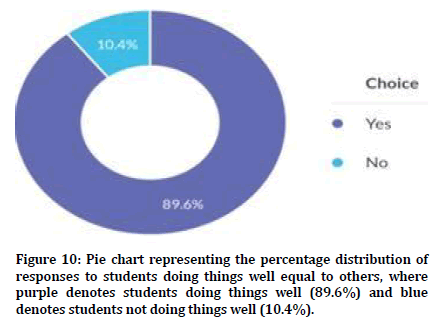
Figure 10. Pie chart representing the percentage distribution of responses to students doing things well equal to others, where purple denotes students doing things well (89.6%) and blue denotes students not doing things well (10.4%).
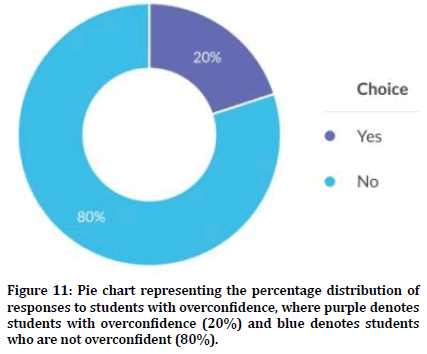
Figure 11. Pie chart representing the percentage distribution of responses to students with overconfidence, where purple denotes students with overconfidence (20%) and blue denotes students who are not overconfident (80%).
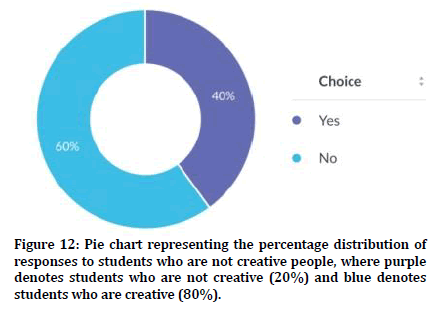
Figure 12. Pie chart representing the percentage distribution of responses to students who are not creative people, where purple denotes students who are not creative (20%) and blue denotes students who are creative (80%).
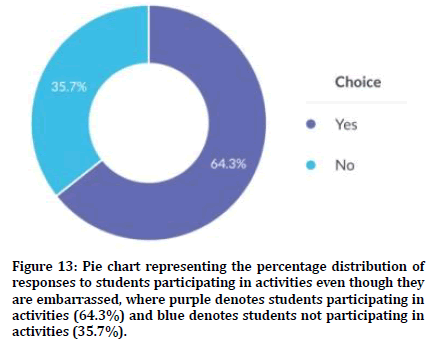
Figure 13. Pie chart representing the percentage distribution of responses to students participating in activities even though they are embarrassed, where purple denotes students participating in activities (64.3%) and blue denotes students not participating in activities (35.7%).
88.7% of participants trusted their feelings and emotions and 11.3% of them do not trust their feelings and emotions (Figure 14). 92.2% of participants said that they felt motivated by the speech of a person who has already achieved and 7.8% of them do not feel motivated (Figure 15). 94.8% of them felt motivated when they see others with more self-confidence (Figure 16).
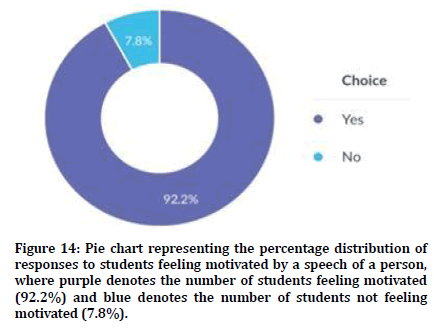
Figure 14. Pie chart representing the percentage distribution of responses to students feeling motivated by a speech of a person, where purple denotes the number of students feeling motivated (92.2%) and blue denotes the number of students not feeling motivated (7.8%).
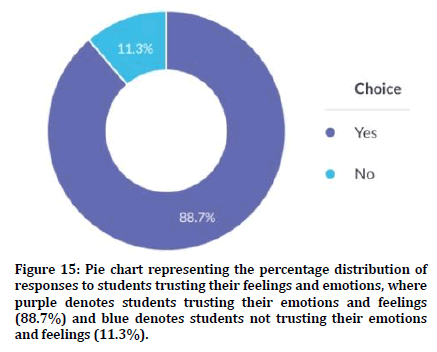
Figure 15. Pie chart representing the percentage distribution of responses to students trusting their feelings and emotions, where purple denotes students trusting their emotions and feelings (88.7%) and blue denotes students not trusting their emotions and feelings (11.3%).
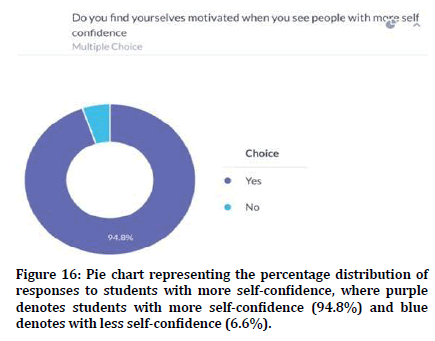
Figure 16. Pie chart representing the percentage distribution of responses to students with more self-confidence, where purple denotes students with more self-confidence (94.8%) and blue denotes with less self-confidence (6.6%).
Positive Friendships can bring the best out of an individual; because of this they can develop more self-confidence [4]. Students in the surgical field always tend to have more confidence levels [12]. 95% of students were confident among them 5% of students were over confident [21].
Conclusion
In this study the students seem to have high confidence levels. It is proved that people who lack self-confidence gain confidence level by their role models or people who have already achieved their dreams but we should not be overconfident which will also sometimes lead to failures in our career or other things. So selfconfidence is important to achieve our dreams and we should have confidence in a positive way. We can achieve self-confidence by affirming ourselves. Seminars, workshops on motivation, time management may be conducted in schools and colleges to boost the confidence level of students. Increase in confidence level will make the students to achieve higher positions in the society.
Acknowledgment
We thank Saveetha Dental College for providing us the support to conduct the study.
Conflict of Interest
Nil.
References
- Komarraju M, Musulkin S, Bhattacharya G. Role of student–faculty interactions in developing college students' academic self-concept, motivation, and achievement. J Coll Stud Dev 2010; 51:332-342.
- Shrauger JS, Schohn M. Self-confidence in college students: Conceptualization, measurement, and behavioral implications. Assessment 1995; 2:255-278.
- Laird TF. College students’ experiences with diversity and their effects on academic self-confidence, social agency, and disposition toward critical thinking. Res High Educ 2005; 46:365-387.
- Antonio AL. The influence of friendship groups on intellectual self-confidence and educational aspirations in college. J Higher Educ 2004; 75:446-471.
- Freund Y, Duchateau FX, Baker EC, et al. Self-perception of knowledge and confidence in performing basic life support among medical students. Eur J Emerg Med 2013; 20:193-196.
- Lundberg KM. Promoting self-confidence in clinical nursing students. Nurse Educ 2008; 33:86-89.
- Tavani CM, Losh SC. Motivation, self-confidence, and expectations as predictors of the academic performances among our high school students. Child Dev 2003; 33:141-152.
- Han A, Cho DS, Won J. A study on learning experiences and self-confidence of core nursing skills in nursing practicum among final year nursing students. J Korean Acad Fundam Nurs 2014; 21:162.
- Telbis NM, Helgeson L, Kingsbury C. International students’ confidence and academic success. J Int Stud 2014; 4:330-341.
- Morgan PJ, Cleave‐Hogg D. Comparison between medical students' experience, confidence and competence. Med Educ 2002; 36:534-539.
- Obidigbo GC. The relationship between self-concept and academic performance of Nigerian students. Ife Psychol Int J 2002; 10:38-48.
- Barr J, Graffeo CS. Procedural experience and confidence among graduating medical students. J Surg Educ 2016; 73:466-473.
- Komarraju M, Musulkin S, Bhattacharya G. Role of student–faculty interactions in developing college students' academic self-concept, motivation, and achievement. Journal of college student development 2010; 51:332-342.
- Gerdes H, Mallinckrodt B. Emotional, social, and academic adjustment of college students: A longitudinal study of retention. J Couns Dev 1994; 72:281-288.
- Menon A, Priya PV, Gayathri R. Preliminary phytochemical analysis and cytotoxicity potential of pineapple extract on oral cancer cell lines. Asian J Pharm Clin Res 2016; 9:140-143.
- Priya VV, Jainu M, Mohan SK. Biochemical evidence for the antitumor potential of Garcinia mangostana Linn. On diethylnitrosamine-induced hepatic carcinoma. Pharmacogn Mag 2018; 14:186.
- Chen F, Tang Y, Sun Y, et al. 6-shogaol, a active constiuents of ginger prevents UVB radiation mediated inflammation and oxidative stress through modulating NrF2 signaling in human epidermal keratinocytes (HaCaT cells). J Photochem Photobiol B Biol 2019; 197:111518.
- Gan H, Zhang Y, Zhou Q, et al. Zingerone induced caspase‐dependent apoptosis in MCF‐7 cells and prevents 7, 12‐dimethylbenz (a) anthracene‐induced mammary carcinogenesis in experimental rats. J Biochem Mol Toxicol 2019; 33:e22387.
- Ma Y, Karunakaran T, Veeraraghavan VP, et al. Sesame inhibits cell proliferation and induces apoptosis through inhibition of STAT-3 translocation in thyroid cancer cell lines (FTC-133). Biotechnol Bioprocess Eng 2019; 24:646-652.
- Wang Y, Zhang Y, Guo Y, et al. Synthesis of Zinc oxide nanoparticles from Marsdenia tenacissima inhibits the cell proliferation and induces apoptosis in laryngeal cancer cells (Hep-2). J Photochem Photobiol B Biol 2019; 201:111624.
- Molteni VE, Chan EK. Student confidence/overconfidence in the research process. J Acad Librariansh 2015; 41:2-8.
Author Info
Shilpa Merlyn Jose, Vishnu Priya V* and Gayathri R
Department of Biochemistry, Saveetha Dental College and Hospitals, Saveetha Institute of Medical and Technical Sciences, Saveetha University Tamilnadu, Chennai, IndiaCitation: Shilpa Merlyn Jose, Vishnu Priya V, Gayathri R, Awareness on Confidence Level Among College Students, J Res Med Dent Sci, 2021, 9 (1): 345-349.
Received: 23-Sep-2020 Accepted: 11-Jan-2021
